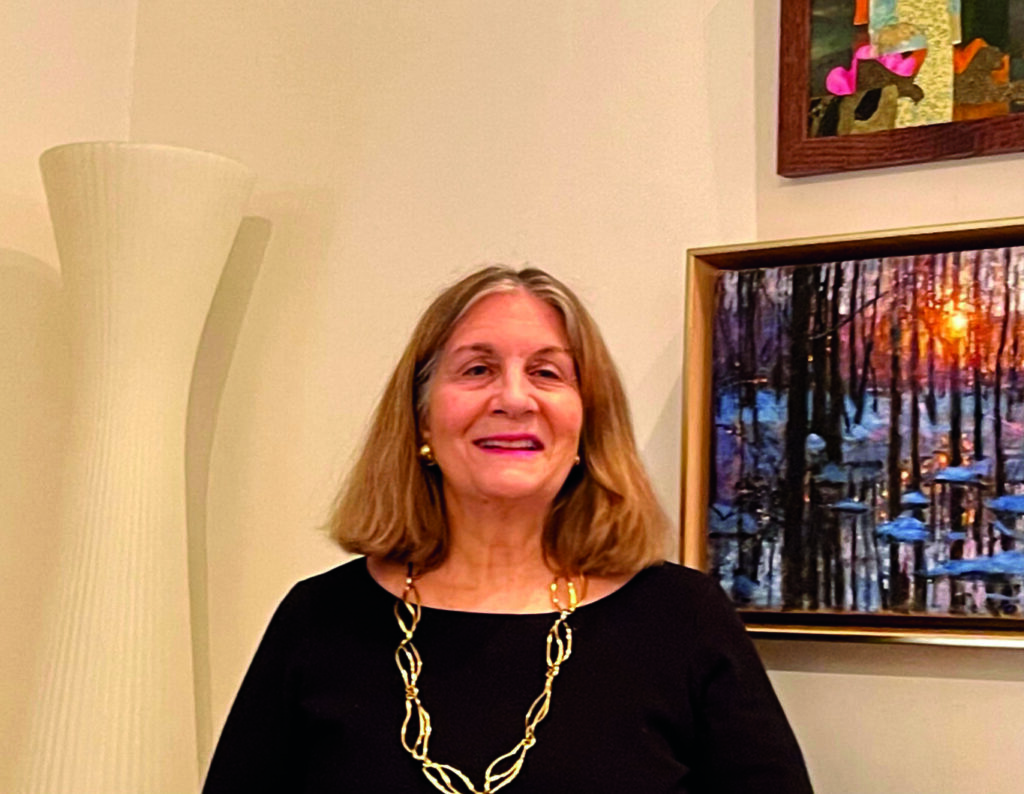Virginia Fabbri Butera ’73
DEGREES

Interdisciplinary B.A. in Renaissance studies (courses included Italian, French, and English art; history; literature; and philosophy); M.A. in history of art, Johns Hopkins University; Ph.D. in art history, CUNY Graduate Center
JOB TITLES
Art historian, professor, curator, and collector
FAVORITE TRINITY MEMORY
There are so many memories, especially of exchanging ideas with classmates. I continue to have great conversations with friends Larry Pistell and Aron Pasternack, whom I met on my first day on campus!
What were some highlights of your training and career?
After a stint in a fine art print gallery, I became the 1976–77 Smithsonian Museum Fellow at the Smithsonian American Art Museum in Washington, D.C., where I learned museum work including areas in prints and drawings and 20th-century art. Then I did a National Endowment for the Arts (NEA) Internship in the Print Department of the Philadelphia Museum of Art, where I co-curated eight print exhibitions and mounted two contemporary shows for The Print Club in Philadelphia. Meeting and talking with artists fundamentally changed my focus to contemporary art. From 1978–84, I developed the idea for a show of artists’ folding screens. A colleague and I traveled throughout Europe and the United States, interviewing artists, dealers, and collectors. The Folding Image: Screens by Western Artists of the 19th and 20th Centuries opened in March 1984 at the National Gallery of Art, then at the Yale University Art Gallery. In 1986, I was commissioned to curate Contemporary Screens, which traveled for two years to five major U.S. museums. The highlight was interviewing the artists, seeing their studios, and learning about their processes and ideas. While working on my art history dissertation at the CUNY Graduate Center (I graduated in 2002), I was selected to present a paper at the 50th anniversary of The Frick Collection Symposium in New York City. I won a prize for one of the two best papers. In 1997, while raising my daughter, I began teaching at what is now Saint Elizabeth University in Morristown, New Jersey.
What do you do in your roles?
Over 25 years at Saint Elizabeth, I was sequentially promoted from an adjunct to a professor of art history, tenured, and appointed chair of several departments including Art and Music. I was named director/curator of the Therese A. Maloney Art Gallery in 1997. I taught three or four art history courses each semester covering art from 50,000 B.C.E. to present day and oversaw up to 20 professors each semester. As gallery director, I organized 43 group exhibitions by professional artists and set up yearly exhibitions by our senior art majors. Although recently “retired,” I still teach one course a semester. In addition, as president of Butera Artist Consulting, I help artists develop new exhibitions and assist them with portfolio development and inventory management.
What was your path to your current position?
I realized that teaching would give me flexibility to raise my daughter while still being active in the art world. Over the last quarter century, I have developed more than 60 art shows, moderated almost 20 artists’ panel discussions, and lectured on art, artists, and creativity at many area museums and galleries. Now my daughter, Alanna Fabbri Butera (M.A. in art business from Sotheby’s Institute of Art), is president of Butera Art Advisory and Management, the New York-based art appraisal and advisory firm for which I serve as vice president.
What do you enjoy most about your work?
I love seeing the ever-expanding ideas and radical use of materials that artists bring to their practice. This, in turn, inspires the students and helps me develop new exhibition ideas. I have also had the fun of developing my own art collection!
What challenges do you face?
It is very hard to keep up with local, national, and international artists and trends. Every day I discover amazing works and am excited because of the continued expansion and recognition of who made/makes art. Ideas and themes have increased exponentially and broadened the diversity of artistic and cultural voices and expressions, so we have a myriad of ways to celebrate human creativity.
Did you have a professor at Trinity who was particularly influential?
Curiosity, dedication, and enthusiasm around learning and developing ideas made professors such as Michael Campo, Borden Painter, Hugh Ogden, and Dori Katz inspiring mentors for me. They taught me new strategies for thinking about and expressing unconventional ideas.
